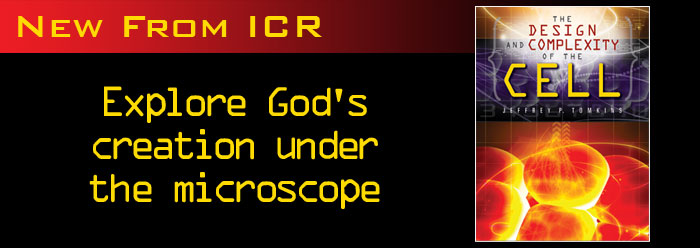The Design and Complexity of the Cell
 The majority of scientifically trained biologists and geneticists are taught that the apparent design that is observed in cells is the result of only random chemical and energy processes operating over eons of time. However, multiple thousands of scientists accept the Bible’s message that there is a Creator who planned the creation, designed the intricate engineering efficiencies into that creation, and then built the product: our planet and its wonderfully unique life and functions.
The majority of scientifically trained biologists and geneticists are taught that the apparent design that is observed in cells is the result of only random chemical and energy processes operating over eons of time. However, multiple thousands of scientists accept the Bible’s message that there is a Creator who planned the creation, designed the intricate engineering efficiencies into that creation, and then built the product: our planet and its wonderfully unique life and functions.
In The Design and Complexity of the Cell, Dr. Jeffrey Tomkins and his contributing colleagues document and help explain the intricate processes of cells, and give keen insight for “clearly seeing” the obvious hand of the Creator in the “things that are made” (Romans 1:20).
This beautiful, full-color book in hardcover is only $19.99 (plus shipping and handling). Click here to order your copy today!
Foreword
The functions within the cells of our bodies are foundational to our existence. Understanding these functions has made the environment and the processes of our lifestyles healthier, more enjoyable, and more productive. All of humanity has benefited from the life sciences and the scientists who have dedicated their considerable skills to uncovering the functions and processes of the multifaceted variety of cells.
Although scientists have discovered, documented, and developed wonderful insights about the complex information, precise sequential processes, and unique interwoven controls within cells, there is a huge chasm among scientists when they try to understand how these highly efficient processes got started in the first place.
The majority of scientifically trained biologists and geneticists are taught that the apparent design that is observed in cells is the result of only random chemical and energy processes operating over eons of time. Such a belief system prompts their thinking to rest on purely natural logic, producing materialistic conclusions— and often ignoring or marginalizing the implications of careful engineering and design.
There are, however, multiple thousands of scientists who accept the Bible’s message that there is a Creator who planned the creation, designed the intricate engineering efficiencies into that creation, and then built the product: our planet and its wonderfully unique life and functions. That belief system not only fits empirically with what is observed (design, precise function, operational efficiencies, etc.), but provides insight that enables creation-based scientists to grasp the significance of the information more readily—without having to invent a supposed eons-long story for the development of what is actually observed. Dr. Jeffrey Tomkins and his contributing colleagues have provided an excellent resource that will document and help explain the intricate processes of cells and give some keen insight for “clearly seeing” the obvious hand of the Creator in the “things that are made” (Romans 1:20).
Each chapter is written for technical accuracy. Most high school biology students will find the information similar to what is in their textbooks—but more carefully explained regarding the clear presence of design. Interspersed throughout the book are short articles that will provide specific examples of the cellular functions as they impact system operation. These examples will provide observable applications of how these marvelous processes insure that the purpose of each design is fulfilled.
At the end of each chapter is an information summary that will reinforce the science discussed and outline the design characteristics easily identified by the discoveries.
This book is designed as a scientific resource and ready reference, as well as an apologetic tool to use as a witness of the omnipotent and omniscient Creator and Savior. Our prayer at the Institute for Creation Research is that you will find both of these purposes fulfilled in your life.
 Henry M. Morris III
Henry M. Morris III
Chief Executive Officer
Institute for Creation Research
Click here to purchase The Design and Complexity of the Cell.
Click here to return to the main web page for The Design and Complexity of the Cell.









